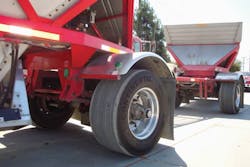Wide-base repair
As more wide-base medium truck tires hit the road, more of them will be brought into commercial tire dealerships for both nail hole and section repairs.
The good news is that repair procedures for wide-base truck tires are identical to repair procedures for conventional medium truck tires: inspect the tire, clean it out, make sure there’s no oxidation and apply the proper patch as specified by the patch’s manufacturer. At the same time, there are several factors to consider when performing a wide-base repair. Most of them relate to the unique design and dimensions of wide-base tires.
‘Give more leeway’
“We know the belts (in a wide-base truck tire) work a lot more and the reason for that is the wide-base footprint is much wider than longer,” says Roger Stansbie, director of tire technology, Commercial Vehicle Tires, the Americas, Continental Tire North America Inc. “That means the belt wires course in and out of the footprint a lot more than in a conventional tire.”
This leads to twisting, which puts more stress on the tire’s belt edges. “What this means is the designated zone for non-repair, which has always been one inch from the shoulder point, has to be absolutely respected. If you have a repair there, even with all the best intentions in the world, you’re going to have a potential weak spot. If anything’s going to go wrong, it will go wrong there.
“I would suggest that anyone who is repairing these tires give a lot more leeway than you would in a conventional tire,” says Stansbie. “I would stay well away from the shoulder groove.”
Stansbie says repair techs can use regular patches when repairing wide-base tires “as long as the patch conforms to the dimensions and applications that the manufacturer puts on it.”
Having the correct range of patches on hand is critical. Otherwise, service techs may be tempted to apply a longer patch “and that could be a concern with shorter sidewalls.”
Complete inspection
When working with wide-base tires, “the biggest area where people make mistakes or overlook things is initial inspection,” says Norm Ball, training manager and director of franchise business services, Michelin Retread Technologies Inc. “You have to take your time and look, both on the initial inspection stand and after the buff. You want to make sure there are no cracks that would indicate there’s something else going on.”
Guy Walenga, director of engineering for commercial products and technologies, Bridgestone Americas Tire Operations LLC, also recommends taking your time during inspection. And don’t forget after-repair inspection, he says. “When you’re in your zone, you sometimes may not pay attention to what you’ve done. When the repair is finished and before the tire gets remounted, it’s important that you do one last inspection to make sure that repair is tight and right.”
In addition, be careful when moving wide-base truck tires around the shop. They’re bigger and heavier than conventional truck tires, and thus require extra care. “Everybody talks about ‘wide base’ and ‘light weight,’” in relation to the overall weight savings that a full set of wide-base truck tires can produce for a rig,” says Walenga. “But when someone walks up to a wide-base tire and tries to move it, they understand” that wide-base tires are heavier and bulkier. “It’s lighter than two tires, but you don’t move two (regular truck) tires at one time." ■
